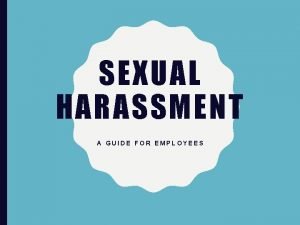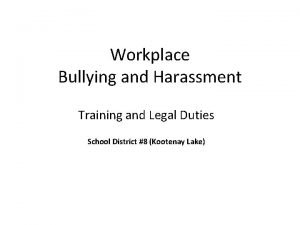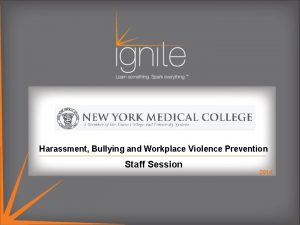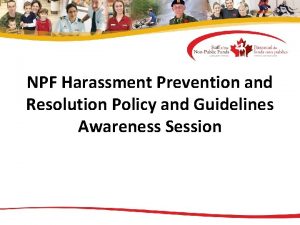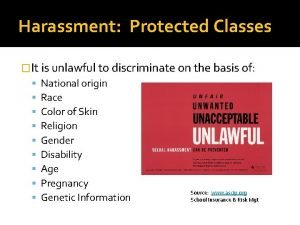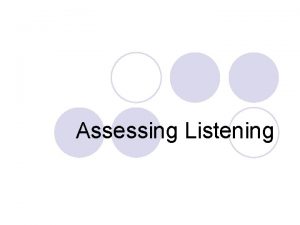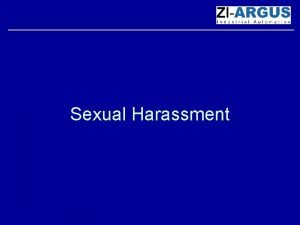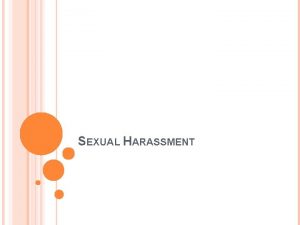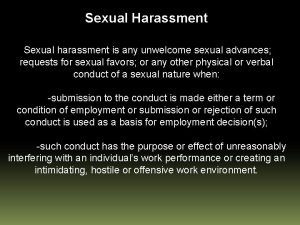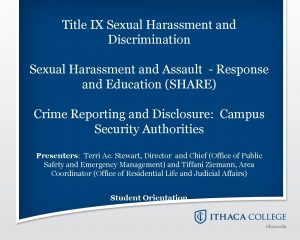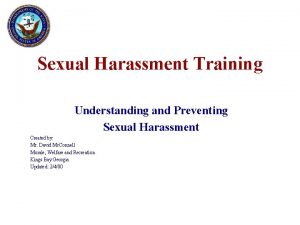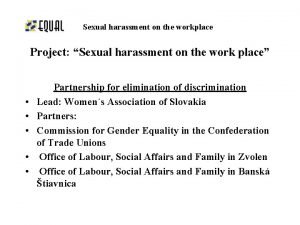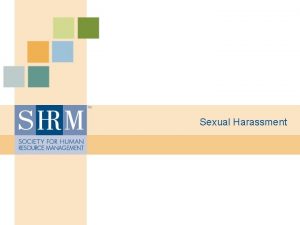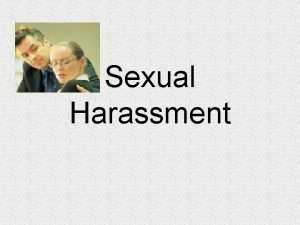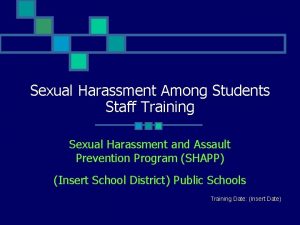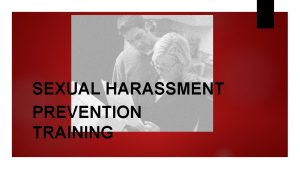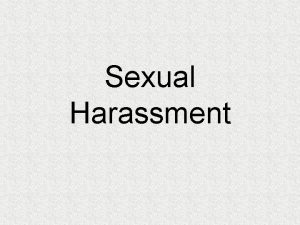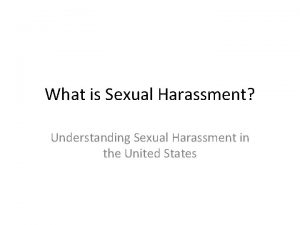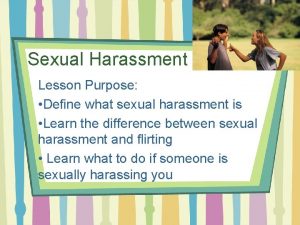Recognizing and Responding to Sexual Harassment As we





























- Slides: 29

Recognizing and Responding to Sexual Harassment “As we work to make Oregon State University a safe, inclusive, and nurturing community for all of us, it is imperative that we end any form of harassment on campus. I expect each and every member of the OSU community to become informed about harassment and to take responsibility for preventing harassment in all its forms. ” --Oregon State University President Ed Ray Office of Equity and Inclusion

Learning Objectives At the end of this online module, you will understand: n n What sexual harassment looks like and how it is defined by Oregon State University (OSU). How to respond if you experience sexual harassment, including how to access resources. What your responsibilities are if you learn of or have reason to believe that sexual harassment is occurring. How OSU works to address and prevent sexual harassment. Office of Equity and Inclusion Revised: August 3, 2012

Still a Problem? Despite the low numbers of formal complaints, surveys and direct evidence gathered by OSU and other institutions show that sexual harassment is a serious problem. Examples include: n Workplace estimates of sexual harassment range from 40 to 75 percent. n Men and women are equally likely to be harassed; however, both men and women are most likely to identify a man as the alleged harasser. n n Lesbian, gay, bisexual, and/or transgender employees are more likely to experience sexual harassment than heterosexual employees. Individuals with disabilities are more likely to experience sexual harassment. Most people report that they are harassed by someone with greater positional power. More than one-third of individuals do report sexual harassment to someone who can respond. Data from American Association of University Women 2005 Survey and the Thompson Educator’s Guide to Controlling Sexual Harassment

Why is it Underreported? Some of the reasons why individuals do not report sexual harassment include: n Worry about not being believed. n Fear about having done something to “deserve” the harassment. n Distrust that anyone can or will help. n Worry about confidentiality. n Concern about bad reactions like not getting a raise or losing a job. n Uncertainty about where to seek help. n Lack of understanding about the definition of sexual harassment. Office of Equity and Inclusion Revised: August 3, 2012

Applicable Laws Some of the relevant laws and regulations include: n Title VII of the Civil Rights Act of 1964, as Amended which prohibits employment discrimination on the basis of sex. n Title IX of the Education Amendments of 1972 which prohibits sex discrimination in educational institutions that receive federal funding. Sexual harassment, which includes acts of sexual violence, is a form of sex discrimination prohibited by Title IX. n Additional state and local laws. Office of Equity and Inclusion Revised: August 3, 2012

OSU’s Definition of Sexual Harassment is defined as: Unwelcome* sexual advances, requests for sexual favors, and other verbal or physical conduct of a sexual nature when: n Submission to such conduct is made either explicitly or implicitly a term or condition of an individual’s employment or education; n Submission to or rejection of such conduct by an individual is used as the basis for employment or education-related decisions affecting such an individual; or n Such conduct is sufficiently severe or pervasive that is has the effect, intended or unintended, of unreasonably interfering with an individual’s work or academic performance because it has created an intimidating, hostile, or offensive environment and would have such an effect on a reasonable person of that individual’s status. *Employee conduct directed towards a student–whether unwelcome or welcome–can constitute sexual harassment under OAR 580 -015 -0010(2).

Quid Pro Quo Harassment There are two types of sexual harassment: quid pro quo and hostile environment. Quid pro quo: n Latin for “this for that” or “something for something” n Refers to an exchange Example 1: An exchange between employees, where one is asked to provide sexual favors in exchange for something else such as favorable treatment in work assignments, pay, or promotion. Example 2: An exchange between a faculty member and a student where the student is asked by the faculty member to engage in a romantic relationship or receive a failing grade in the class. Office of Equity and Inclusion Revised: August 3, 2012

Hostile Environment Harassment There are two types of sexual harassment: quid pro quo and hostile environment. The factors that determine whether an environment is hostile include: n Subjective Experience Does the person who experienced the behavior think that the environment is hostile? n Reasonable Person Standard § § Is the behavior severe and/or pervasive? Would another person in a similar situation identify the behavior as sexual harassment? Office of Equity and Inclusion Revised: August 3, 2012

Hostile Environment Harassment (continued) n Adverse Effect It is not necessary for the harasser to mean to cause discomfort. It only matters that the effect of their behavior is harmful (i. e. , an intimidating, uncomfortable, or hostile environment is created). Office of Equity and Inclusion Revised: August 3, 2012

What Can it Look Like? Sexual harassment involves conduct that is about sex or sexuality, or that is directed at someone because of their sex. Examples of behavior that is about sex or sexuality can include: n n n Making sexual comments, jokes, gestures, or looks. Displaying sexual pictures, photographs, or Web pages. Sending sexual text and/or picture messages. Spreading rumors, such as those about an individual’s sexual behavior or sexual orientation. Touching, grabbing, or pinching in a sexual way. Asking someone to do something sexual in exchange for something else (Quid pro quo harassment). Office of Equity and Inclusion Revised: August 3, 2012

Other Examples of Sexual Harassment Sexual harassment involves conduct that is about sex or sexuality, or that is directed at someone because of their sex. Examples of behavior that is directed at someone because of their sex can include: n Making sexist or homophobic comments. n Pressuring someone to engage in an unwanted relationship. n Giving unwelcome gifts. n Treating someone differently based on their sex. Office of Equity and Inclusion Revised: August 3, 2012

Sexual Violence Sexual violence is also considered a form of sexual harassment. Sexual violence is sexual or gender-based behavior that is unwanted and/or nonconsensual, and has the effect of producing harm. It includes behavior along a continuum of severity, from offensive comments to physical violence, including but not limited to rape. Office of Equity and Inclusion Revised: August 3, 2012

Your Responsibilities As an employee of Oregon State University, you are responsible for responding appropriately. n If you receive information about or have reason to believe that sexual harassment is: § § n Occurring/has occurred on university property or during a university activity, or Being/has been committed by a university community member (student/staff/faculty), then Contact the Office of Equity and Inclusion (OEI). It is not your responsibility to determine what happened or the appropriate outcome. Office of Equity and Inclusion Revised: August 3, 2012

What Will I Be Asked to Share? n n If the alleged perpetrator is a university employee (faculty, staff, and in some instances student employees), you will be required to provide information about the alleged perpetrator’s identity so the university can determine an appropriate response. If the alleged perpetrator is unknown or is not a university employee, you will be asked to provide non -personally identifiable information for required record-keeping purposes. Office of Equity and Inclusion Revised: August 3, 2012

Confidentiality It can be difficult for anyone who experiences sexual harassment to tell someone. If someone makes a report, it is important that you: n Inform them of their options; n Address their concerns; and n Tell them that you will respect their privacy while letting them know that you may have a limited ability to ensure full confidentiality. Office of Equity and Inclusion Revised: August 3, 2012

What to Say: Sample Statement It is important to communicate the limits to your ability to maintain confidentiality as soon as possible in the conversation. n n If individuals would prefer to speak with someone confidentially, your role is to help connect them to someone who can maintain confidentiality before identifying information is disclosed. Sample statement: “I will respect your privacy; however, I am not a confidential resource. If you would like to speak to someone confidentially, I can help you find the right person to talk to. If you would like to continue talking with me and you tell me details about what happened, who was involved, and/or where it happened, I will need to consult with the Office of Equity and Inclusion to share some of that information. ” Office of Equity and Inclusion Revised: August 3, 2012

Response Guidelines If someone tells you about an experience of sexual harassment you should: n Take the individual seriously. n Address the individual’s concern. n Respond with care. n Be fair and reserve judgment about the individuals involved. n Offer resources, including the OEI. n Consult with the OEI. Office of Equity and Inclusion Revised: August 3, 2012

Contacts & Resources (Resources are available as a printable file following this module. ) Office of Equity and Inclusion n 541. 737. 3556 Confidential support, counseling, and advocacy: § Center Against Rape and Domestic Violence (CARDV) 541. 754. 0110 § Sexual Assault Support Services (SASS) (students only) 541. 737. 7604 § Employee Assistance Program (employees only) 800. 433. 2320 Reporting options § Oregon State Police at OSU § Student Conduct and Community Standards 541. 737. 3010 541. 737. 3656 In case of emergency § OSU Department of Public Safety § If you witness violence or are in immediate danger 541. 737. 7000 911 Office of Equity and Inclusion Revised: August 3, 2012

Your Own Behavior We each have the responsibility to treat others with respect. The most important thing you can do is to refrain from engaging in any harassing behavior and not tolerate such behavior from others. If someone tells you that s/he experiences your behavior toward her/him as harassment, regardless of your intent: n Listen carefully and take the complaint seriously. n Respond in an appropriate and professional manner; don’t get defensive or try to justify your actions. n Leave the individual alone if you are asked to do so. Office of Equity and Inclusion Revised: August 3, 2012

Your Own Behavior (continued) n n Discuss with your supervisor or the OEI how to manage situations where there is a business necessity to interact with the individual. Express regret for any offensive behavior and agree to treat people appropriately. Speak with a manager or someone else who can facilitate a conversation if you feel wrongly accused or misunderstood. Avoid any actions that could be seen as retaliatory toward the complainant. Office of Equity and Inclusion Revised: August 3, 2012

Retaliation Individuals are protected from retaliation when engaged in certain activities. n Protected activities include: § § § n Expressing a concern to an appropriate authority; Filing a complaint; or Participating in an investigation. Actions considered to be retaliation include: § § § Taking or threatening to take an unfavorable employment action. Withholding or threatening to withhold a favorable employment action. Engaging in actions that could deter complaints. Office of Equity and Inclusion Revised: August 3, 2012

How Must OSU Respond? As an employer and educational institution, OSU has a responsibility to respond to any complaints of sexual harassment quickly and fairly, to immediately correct the situation, prevent its recurrence, and address its effects. The office charged with investigating complaints of harassment is the Office of Equity and Inclusion. The investigation process involves: n Meeting with individuals involved; n Deciding what happened; and n Determining an appropriate response. Office of Equity and Inclusion Revised: August 3, 2012

Possible Outcomes/Sanctions n If harassment is found: § § § n Counseling/education Warning Reprimand Denial of merit raise Transfer § § Denial of promotion and/or tenure Transfer Suspension Termination Although sanctions may be necessary, they are not always adequate. We must also: § § § Strive to eliminate a hostile environment created by the harassment; Address the effect of the misconduct; and Take reasonable steps to ensure that the harassment does not recur. Office of Equity and Inclusion Revised: August 3, 2012

Strategies to Prevent Harassment n n n n Create an atmosphere of respect. Be aware of the potential unintended effects of your own behavior. Model appropriate behavior. Publicize policies and expectations. Schedule training. Create an environment where all feel empowered to voice concerns. Be clear that harassment of any type will not be tolerated. Office of Equity and Inclusion Revised: August 3, 2012

Review of What You’ve Learned n The following 4 slides will provide you with a review of some important points to remember about recognizing and responding to sexual harassment. Office of Equity and Inclusion Revised: August 3, 2012

Review Which of the following is not a common reason why sexual harassment is underreported? A. Individuals fear having done something to “deserve” the harassment. B. Individuals have limited options because OSU has no formal process for reporting sexual harassment. C. Individuals do not trust that anyone can or will help. D. Individuals may fear retaliation. Correct answer is B. There are many reasons why sexual harassment is underreported; however, OSU does provide a formal reporting process. The Office of Equity and Inclusion is responsible for responding to complaints of sexual harassment. Office of Equity and Inclusion Revised: August 3, 2012

Review (continued) An example of Quid pro quo harassment is: A. Spreading rumors about the sexual behaviors of a co-worker. B. An exchange where one co-worker regularly asks another coworker to lunch. C. An exchange between a supervisor and employee where the employee is asked to provide sexual favors in exchange for a promotion. D. Displaying sexual pictures, photographs or Web pages. Correct answer is C. “Quid pro quo” describes harassment where submission to conduct of a sexual nature is either explicitly or implicitly a term or condition of employment. Office of Equity and Inclusion Revised: August 3, 2012

Review (continued) Which of the following is not a factor in determining whether an environment is hostile? A. The subjective experience of an individual who thinks the environment is hostile. B. Whether another person in a similar situation would identify the behavior as sexual harassment. C. A consideration of the nature of the conduct and how often it occurred. D. A consideration of whether the harasser meant to cause discomfort. Correct answer is D. It is not necessary for the harasser to mean to cause discomfort. What matters is that the effect of the behavior is harmful. Office of Equity and Inclusion Revised: August 3, 2012

Review (continued) If a supervisor receives information about or has reason to believe that sexual harassment is occurring, s/he must: A. Consult with the Office of Equity and Inclusion. B. Investigate further to assess whethere really is harassment. C. Keep the information confidential. D. Immediately discipline the harasser. Correct answer is A. Supervisors must consult with the Office of Equity and Inclusion, which is the office responsible for responding to complaints of sexual harassment. Office of Equity and Inclusion Revised: August 3, 2012
 Louisiana sexual harassment training
Louisiana sexual harassment training Objective of sexual harassment
Objective of sexual harassment Boku no sexual harassment manga
Boku no sexual harassment manga Sexual harassment seminar
Sexual harassment seminar Sexual harassment quiz
Sexual harassment quiz Sexual harassment at workplace act nepal
Sexual harassment at workplace act nepal Sexual harassment objectives
Sexual harassment objectives Wsu sexual harassment training
Wsu sexual harassment training Harassment definition
Harassment definition Sexual harassment cases in correctional centres
Sexual harassment cases in correctional centres Sexual harassment is not a joke
Sexual harassment is not a joke Sexual harassment definition
Sexual harassment definition Sexual harassment definition
Sexual harassment definition Bullying and harassment training
Bullying and harassment training Policy on harassment prevention and resolution
Policy on harassment prevention and resolution Framework agreement on harassment and violence at work
Framework agreement on harassment and violence at work Workplace violence and harassment quiz answers
Workplace violence and harassment quiz answers Bullying and harassment training presentation
Bullying and harassment training presentation Useful and harmful household materials
Useful and harmful household materials Trends and opportunities examples
Trends and opportunities examples An opportunity has four essential qualities it is
An opportunity has four essential qualities it is Recognising opportunities
Recognising opportunities Recognizing and resolving abo discrepancies
Recognizing and resolving abo discrepancies Listening answer
Listening answer Recognizing opportunities and generating ideas
Recognizing opportunities and generating ideas Manipulated variable and responding variable graph
Manipulated variable and responding variable graph Why are line graphs powerful tools in science?
Why are line graphs powerful tools in science? Congratulating and responding to congratulations dialogue
Congratulating and responding to congratulations dialogue What is the fourth step of the scientific method
What is the fourth step of the scientific method Manipulated and responding variables
Manipulated and responding variables

